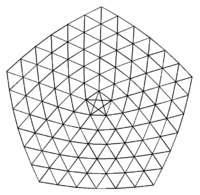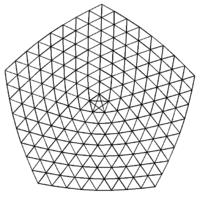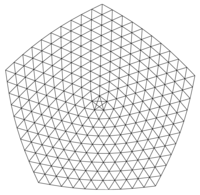
*Star
Encyclopedia
*Star is a complex abstract strategy game by Ea Ea, a designer of Y
. It is a redevelopment of his earlier game Star
.



Two players alternately place stones of their colour on empty nodes. The game ends when the board is filled up (or when both players agree that the score is decided).
Each node on the perimeter of the board counts as one "peri". Connected groups of one color that contain fewer than two peries are removed, with the possible peri going to the surrounding group. Each remaining group is worth the number of peries it contains minus four. The player with more points wins. Draws are decided in favour of the player owning more corners.
For example, a group containing exactly two peries is worth 2-4 = -2 points. This is the same as the two peries being given to the opponent. That is, creating a group with just two peries is worthless unless it disconnects opponent groups or contains a corner.
and Y
where the goal is to connect certain sides of the board to each other. On the other hand, *Star is closely related to Go
in which the goal is to gather more territory than the opponent. Often survival of a group in Go is achieved by connecting it to another one. In Go, all the surrounded area is counted as territory although in practice most of the territory is gathered near the perimeter.
Y (game)
]Y is an abstract strategy game which was first described by Claude Shannon in the early 1950s. Y was independently invented in 1953 by Craige Schensted and Charles Titus...
. It is a redevelopment of his earlier game Star
Star (board game)
Star is a two-player abstract strategy board game developed in by Craige Schensted . It was first published in 1983 in Games magazine. It is connection game, related to games such as Hex, Y, Havannah, and TwixT. Unlike these games, however, the result is based a player having a higher final...
.



Rules
*Star can be played on graphs of different sizes. The three shown boards have 105, 180, and 275 nodes of which 30, 40, and 50 are on the perimeter. Note that the edges between the five centermost nodes cross each other.Two players alternately place stones of their colour on empty nodes. The game ends when the board is filled up (or when both players agree that the score is decided).
Each node on the perimeter of the board counts as one "peri". Connected groups of one color that contain fewer than two peries are removed, with the possible peri going to the surrounding group. Each remaining group is worth the number of peries it contains minus four. The player with more points wins. Draws are decided in favour of the player owning more corners.
For example, a group containing exactly two peries is worth 2-4 = -2 points. This is the same as the two peries being given to the opponent. That is, creating a group with just two peries is worthless unless it disconnects opponent groups or contains a corner.
Comparison to Other Games
*Star is closely related to games of HexHex (board game)
Hex is a board game played on a hexagonal grid, theoretically of any size and several possible shapes, but traditionally as an 11x11 rhombus. Other popular dimensions are 13x13 and 19x19 as a result of the game's relationship to the older game of Go...
and Y
Y (game)
]Y is an abstract strategy game which was first described by Claude Shannon in the early 1950s. Y was independently invented in 1953 by Craige Schensted and Charles Titus...
where the goal is to connect certain sides of the board to each other. On the other hand, *Star is closely related to Go
Go (board game)
Go , is an ancient board game for two players that originated in China more than 2,000 years ago...
in which the goal is to gather more territory than the opponent. Often survival of a group in Go is achieved by connecting it to another one. In Go, all the surrounded area is counted as territory although in practice most of the territory is gathered near the perimeter.

